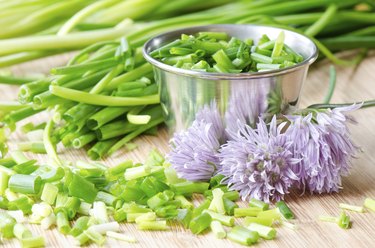
The bulbous perennial herbs known as chives (Allium schoenoprasum) grow approximately 12 to 18 inches tall and yield attractive purple flowers in spring. Their thin, hollow, deep green leaves add a mild onion flavor to a range of foods. Chives are hardy in U.S. Department of Agriculture hardiness zones 4 through 8, but they also grow indoors in pots, allowing enjoyment of these attractive and tasty herbs all year.
Container and Soil
Video of the Day
Plant chives in an unglazed terra cotta pot rather than a plastic one. Indoor herbs grown in plastic containers are more prone to root rot because their roots cannot breathe. Terra cotta is more porous than plastic, so air and water can pass through more easily. The pot should be at least 6 inches in diameter. Ensure the container has drainage holes so the excess water can escape.
Video of the Day
Mix one part compost and one part perlite, vermiculite or sand into regular potting soil. The compost will provide extra nutrients for the growing plant, and the vermiculite helps ensure adequate water drainage.
Planting Chives from Seeds
Chives grow from seeds or bulbs. Start chive plants from seed by adding the mix of potting soil, compost and vermiculite to the terra-cotta container and sowing several seeds on top of the soil. Sprinkle vermiculite lightly over the seeds. Place a sheet of glass or a clear plastic bag over the top and put the container in a sunny, warm location. Seedlings will emerge within seven to 10 days. Once seeds have germinated, remove the cover and allow the plants to grow. One chive seed will produce a clump within several months.
Planting Chives from Bulbs
If you plan to grow potted chives from a bulb that came from a divided clump, start in December or January, preferably after a freeze. The University of Illinois Extension indicates that plants potted in the fall do not do as well as winter plants. Dig a hole as deep as the bulb, and place it gently in the soil. Cover over with soil and water thoroughly.
Sunlight and Water
Place the chive plant in a spot where it can receive at least four or five hours of sunlight each day. If this is not an option, consider putting the plant under grow lights. Check the water moisture in the soil daily. If the soil feels dry, water the plant thoroughly by allowing water to run into the pot until it comes out of the drainage holes.
Fertilizing Indoor Chives
Plants grown in containers need more nutrients than their outdoor counterparts. Feed potted chives every other week with 20-20-20 fertilizer at half the concentration recommended by the manufacturer, or every four to six weeks with a liquid fertilizer at half the recommended strength. One product recommends using 1/2 tsp. of fertilizer to 1 gallon of water. Only add fertilizer when chives are growing.
Harvesting Herbs
You can harvest chives about two months after planting the seeds. Snip the leaves with kitchen or herb scissors about two inches from the bottom of the plant. Use them immediately for cooking or chop the leaves into small pieces, place them in a plastic container and freeze them. The flowers and stalks are not especially tasty and should be thrown away.
Pests and Diseases
Indoor chives rarely suffer from any serious plant diseases. Root rot may occasionally occur, but this problem is easily avoided by making sure the container has adequate drainage. Spider mites, aphids and whiteflies occasionally attack indoor chive plantings. Spray plants with a ready-to-use insecticidal soap every seven to 10 days. Cover the entire plant's surface. Avoid getting insecticidal soap in your eyes, on skin or on clothing, and keep it away from pets. Rinse chives thoroughly before eating them.
Mealybugs and scale may occasionally cause problems as well. These pests do not respond well to organic treatments, and chemical insecticides can render chives inedible. The best option is to discard the plant and start over.
- Missouri Botanical Garden: Allium schoenoprasum
- Richters: The Magazine Rack – Growing Herbs Indoors
- Horticulture: Growing Herbs Indoors
- University of Illinois Extension: Herb Gardening: Chives
- Thomson and Morgan: How to Grow Herbs
- Utah State University Cooperative Extension: Chives in the Garden
- University of Minnesota Extension: Chives